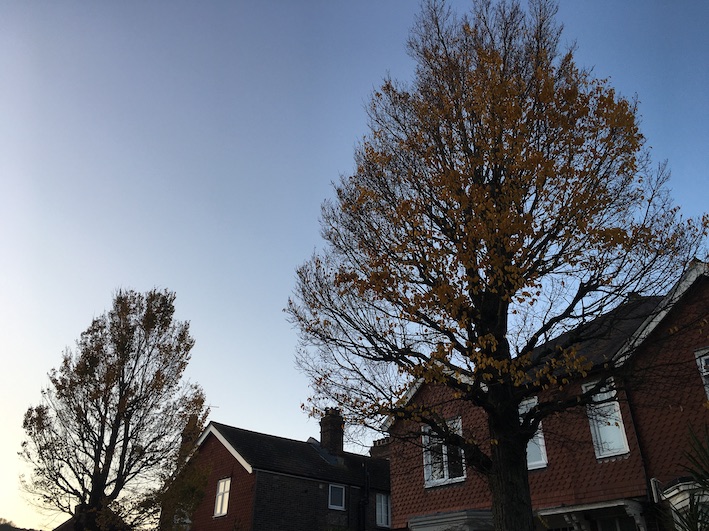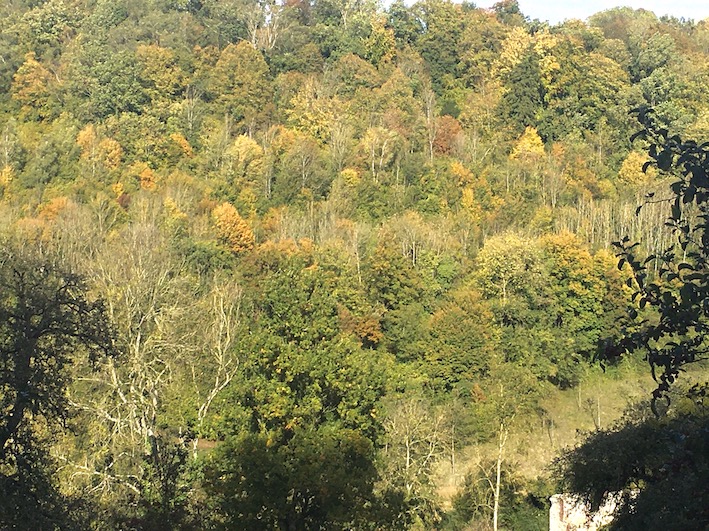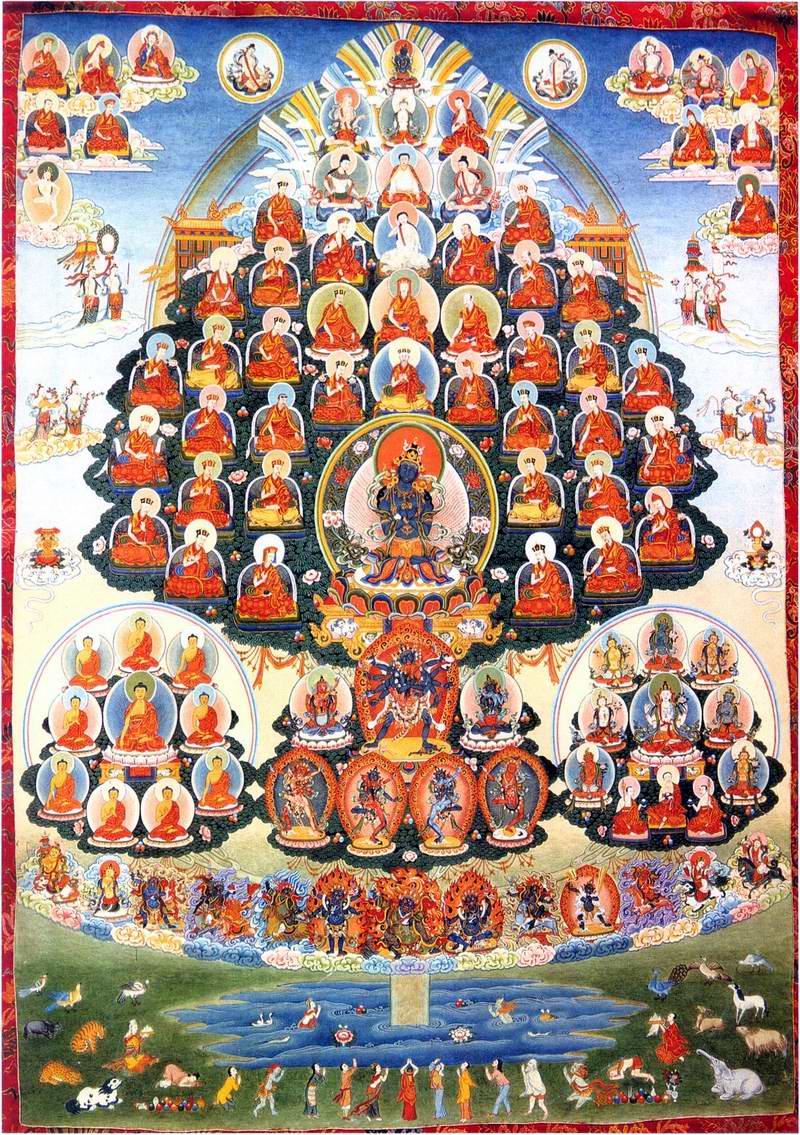 I walked out of my house in the middle of the week and the first sight that registered was a tree surgeons van. They had parked beside one of the Elm trees along our street, and my heart sank: since moving to this street two years ago four Elms have been cut down, victims of Dutch Elm disease. This was to be the fifth. And I knew this was a pattern, the wind borne disease gradually marching down the street towards our end of the road – where two more sit. The “twins”, as I found out from the tree surgeons, were next. The tree surgeons shared my sadness – “we came in to this work because we love trees, and yet people often make us the bad guys”. I have no idea when the twins will meet their fated end, but I make sure I pay homage to the them, nodding their way each time I leave the house and return.
I walked out of my house in the middle of the week and the first sight that registered was a tree surgeons van. They had parked beside one of the Elm trees along our street, and my heart sank: since moving to this street two years ago four Elms have been cut down, victims of Dutch Elm disease. This was to be the fifth. And I knew this was a pattern, the wind borne disease gradually marching down the street towards our end of the road – where two more sit. The “twins”, as I found out from the tree surgeons, were next. The tree surgeons shared my sadness – “we came in to this work because we love trees, and yet people often make us the bad guys”. I have no idea when the twins will meet their fated end, but I make sure I pay homage to the them, nodding their way each time I leave the house and return.
Speaking to neighbours in the street, I am not alone in my sadness. Many of us bought houses here because of the tree lined character so typical of Victorian town planning. You can almost feel the 1900s here, the narrow road, the first motor cars. I can imagine the Elms in their full glory, lining the road like guards.
When the twins go, the vista will change dramatically. And while there are many trees on the Downs in the landscape beyond, it is the proximity of these elder statesman, our street guards, that will be missed. For the twins have given me a sense of time passing, the seasons changing – the young vibrant growth of green heralding spring, the dropping leaves into our gutter the reminder to get warm and turn inward. I look at them now, they sit outside my window as I write, and sadness grows. They don’t even know their fate, I almost feel a sense of betrayal that I know and they don’t.
Trees have long been important in my life. As a child they were my sanctuary. I would climb to their highest branches with my friend Danny. I’d go “missing” for hours over the common land, but mum and Dad knew I was safe. How times have changed.
I grew up in Surrey, a leafy county known for its grand oaks – this is the emblem of the county, two oak leaves. My home from home, the tennis courts, were surrounded by trees. One of my paid jobs was operating the leaf blower – I loved the leaves falling and my cleaning up, call and response, a communication cementing our relationship and again giving me a sense of the seasons.

When I moved to Eastbourne from leafy Surrey, I missed the trees. I’ve since come to appreciate the Downs and seascape here but trees still convey “home”. When training as a cyclist, I would go back to Surrey to see my parents and do my training blocks around all tree lined roads near the Hogs Back. The trees became sustainence on my training rides: they provided much welcome shade, I felt their gift of oxygen, and they acted as markers as to how much ground I had covered. “Nearly there” said the big oaks as I rode through Normandy, just 3 miles to home.
Normandy near the hogs back, not the one over the channel. But more than auspicious that I now spend so much time in theFrench namesake. Normandy reminds me of Surrey and my favourite times of spring and autumn are both times that again the trees dominate the landscapes. On my recent solitary retreat there it was the sense of holding that the trees gave that allowed me to hold and digest my emerging experience.
What is it about trees? I know I’m not alone – sales of the book “The hidden of life of trees” tell us that we are fascinated by them. For me, they have a wisdom – not just the scientifically validated networks and communication skills they have (as revealed in the book by Peter Wohleben). But a wisdom related to their age and time on this Earth. They better than us know how to live with the environment in harmony. They have seen so much. Can you imagine what the grand old red woods of California have witnessed in their thousand year lives?
 I feel safe with trees. Their compassion, their sturdy trunks can be trusted, and their intricate branches “hold”. They are stoic yet flexible. Deep roots yet the ability to “go with” the elements. I often use the tree in metaphor with clients: “feel your roots, and let yourself feel the emotions like the wind through a tree – blown but not broken”. Furthermore, they also keep our secrets: they see all, share nothing. When on retreat, they have often been the place I go to for a safe harbour and “time out”.
I feel safe with trees. Their compassion, their sturdy trunks can be trusted, and their intricate branches “hold”. They are stoic yet flexible. Deep roots yet the ability to “go with” the elements. I often use the tree in metaphor with clients: “feel your roots, and let yourself feel the emotions like the wind through a tree – blown but not broken”. Furthermore, they also keep our secrets: they see all, share nothing. When on retreat, they have often been the place I go to for a safe harbour and “time out”.
The tree is a powerful symbol in my current practices as a fledging Vajrayana Buddhist. When a student enters the Vajrayana, they are called upon to put their trust in the lineage, the ancestors that have previously walked the same path. This call to trust is in the shape of a tree, what is called The Refuge Tree. Bringing this iconography in to a visualisation was central to my solitary retreat time in Normandy recently; and the parallels between what was experienced in my mind (on the cushion) and outside my window formed a very powerful support. Reflection of inner and outer.
And now, the outer tree reflects back an inner process explores on the cushion. One way that life and practice now intermingle…as the dharma indeed intends.

